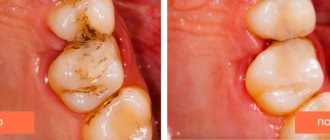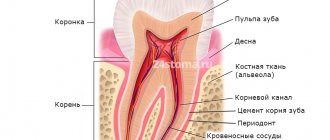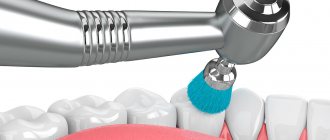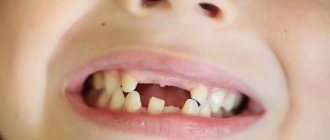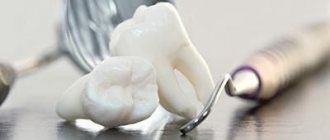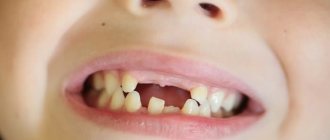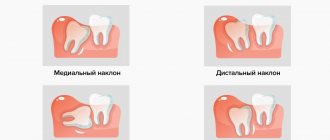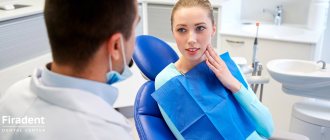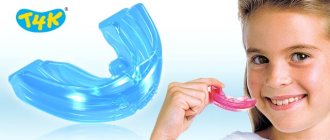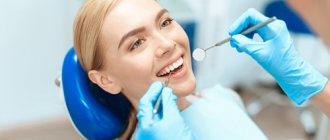How many teeth should a child have?
By the age of three, a child usually already has a full set of twenty primary teeth, and until about 6 years old, their number remains unchanged. Adolescents aged 13 to 18 years should normally have from 28 to 32 molars (depending on the presence of eights, which may erupt after 21 years or not appear at all).
Delete or leave unchanged
This is a topic of active debate among dentists and researchers. Regardless of how old people are when wisdom teeth appear, doctors recommend removing them. There are a number of contraindications for removal:
- missing 1 or 2 molars (6 and 7 in a row);
- the tooth position is vertical;
- history of viral infections in the active stage;
- There is a possibility of treatment for caries.
Age 17, 20 or 35 – it is not so important at what age a wisdom tooth comes out in the jaw. If you feel good, there are no acute inflammatory processes in the gums, and there is no crowding of other teeth, removal can be postponed. This is normal dental practice. If there is aching pain, intoxication with high fever, signs of gumboil, removal is indicated in 99% of cases. Knowing the information at what age wisdom teeth come out in men and women, you can mentally prepare for this process. Everything else and the peculiarities of the development of events depend on genetics and nature. Monitor your condition, undergo preventive examinations on time and, if urgently necessary, seek dental care.
What teeth appear first in children?
The rudiments of baby teeth and even some molars begin to form at the stage of intrauterine development, so modern diagnostic technologies make it possible to track this process and prevent some deviations. After birth, the first teeth usually begin to erupt when the baby reaches six months of age. This means he will soon be ready to eat more solid foods. In the vast majority of cases, the incisors appear first: as a rule, the lower central incisor becomes the “pioneer”.
Typical problems
Usually in this age period the formation of the dental-jaw system proceeds without problems. There is not a single temporary tooth left in the mouth of a twelve-year-old child, and this period is the most favorable for treating malocclusion with braces. Since jaw growth begins to slow down by the age of 15, orthodontic treatment must be carried out before this age in order to avoid the removal of permanent teeth.
Lack of space for the eruption of the canine and permanent premolars occurs if temporary molars were removed in childhood and the corresponding correction was not carried out. The canine is the last one to erupt and it is the one that lacks space. Crowding of teeth is formed in the anterior part of the jaws and the fangs in this case can erupt closer to the lip outside the dental arch.
The formation or aggravation of crowding of teeth is possible in the case of incorrect location of the rudiment of the third molar on the lower jaw. As a result, the pressure exerted by the wisdom tooth on the second molar can lead to an anterior displacement of the entire dentition. Since there is not enough space in the row for an incorrectly positioned wisdom tooth, its complete eruption is impossible. And its retention, that is, incomplete eruption, leads to poor oral hygiene and, as a consequence, the development of carious processes both on the eighth tooth and on the adjacent second molar.
Child's front teeth
Since a child’s front teeth usually erupt earlier than the rest, they can be used to track how the baby’s body tolerates this process. It can occur in different ways: some children are practically not worried, while others, on the contrary, experience stress and discomfort. Swelling of the gums at the site of the future tooth, itching and pain, as well as a slight increase in temperature are the main negative aspects associated with the appearance of the first teeth. When teething baby molars, children may experience runny nose and cough.
Advice for teenagers
In order for a young man to smile widely, he needs to monitor and care for his dental health correctly:
- Brush your teeth and floss twice a day to avoid plaque deposits;
- limit the consumption of sweets and starchy foods, create a diet of foods that do not harm teeth;
- undergo regular dental examinations;
- if a malocclusion develops, visit an orthodontist, who will recommend the best treatment option - braces, dental plates;
- if a teenager is involved in active sports, then he should wear protective mouthguards to protect his teeth and gums from injury;
- avoid bad habits such as smoking, which causes plaque deposits, bad breath and can lead to cancer;
- if you want to somehow express yourself and make yourself a piece of jewelry, for example, tongue or lip piercing, you don’t need to do it in unsanitary conditions, it’s better to go to the dentist, talk about your desire, and he will advise what measures should be taken;
- It is impossible to whiten your teeth at home, but you can maintain whiteness after professional whitening with the help of whitening pastes; in no case should you use chemical elements to make your smile snow-white on your own, without the supervision of a doctor.
It is important for parents to understand that teenagers are children, but they cannot simply be ordered around. They need to be taught, mentored, and shown a positive example of a healthy lifestyle. And it is very important to teach him to take care of his oral and dental health and regularly visit the dentist and make visits to the doctor every six months a habit that he will take with him into adulthood.
How do children's teeth grow?
There is no need to panic if the child’s teeth growth does not fit into the above scheme. A delay of 1 - 3 months is considered normal and is associated with the individual characteristics of the body. Children under one year of age often have teeth that do not appear on schedule or may not appear at all. In the latter case, you need to contact your dentist who will help identify the cause.
What determines the symptoms of teething?
At what age do wisdom teeth erupt and what symptoms of this process depend on the individual characteristics and position in the jaw bone. The more abnormal the position, the more problematic it is. Impacted teeth (unerupted) cause particular inconvenience. They can grow at the wrong angle, put pressure on the “sevens”, and cause inflammation and bleeding of the gums. With such symptoms, the development of infection makes the situation worse. An unpleasant odor, shooting pain, and redness of the gums indicate active inflammation with the formation of pus. The situation is dangerous in terms of location, proximity to the brain and the possible development of complications.
Tooth growth abnormalities in children
Unfortunately, the development and growth of teeth in children does not always occur as expected: there are a number of anomalies of various types that in one way or another affect the aesthetics and/or functionality of the teeth.
Causes of impaired growth and development of teeth:
- bad heredity;
- fetal injury during pregnancy or birth; intrauterine growth retardation, infections and so on;
- disruption of the endocrine system, thyroid dysfunction;
- lack of vitamins and minerals;
- mechanical, thermal and chemical injuries to teeth;
- bad habits in children that can affect the formation of teeth;
- lack of proper hygiene and poor diet.
Below is a table that describes the most common types of dental anomalies in children.
| Anomaly class | Description |
| Size of teeth | There are microdentia (too small teeth) and macrodentia (too large teeth). The anomaly can affect one or several teeth (and even the entire dentition). |
| Number of teeth | There is partial (lack of several teeth) and complete (absence of all teeth) adentia. Hyperdentia is a supernumerary set of teeth (usually in the second row). |
| Shape of teeth | Cone-shaped, barrel-shaped (Hutchinson's teeth), Pflueger's teeth (the neck is more developed than the coronal part). |
| Anomalies in the structure of enamel and dentin | Hypoplasia (spots and grooves on the body of the tooth), hyperplasia (tubercles, enamel drops, etc.), dentinogenesis imperfecta (violation of the structure and color of dentin). |
| Color irregularities | Enamel pigmentation (gray, black, amber enamel color). Most often it is caused by a disruption of the immune system during the prenatal stage of development. |
| Malocclusion | All types of dental malocclusions: mesial, cross, open, deep and so on. |
Despite the fact that some dental anomalies in children are quite serious, a timely visit to the dentist will help you avoid problems and maintain the health and beauty of your smile. If you let the situation take its course, unpleasant consequences will not keep you waiting.
What should you do when the third molar is cut?
Often the eruption of the third molar on the upper jaw is completely asymptomatic. On the lower jaw, this is only possible if there is space. If there is not enough space, the wisdom tooth begins to erupt to the side, pushing the adjacent tooth, which is accompanied by pain and inflammatory symptoms around the third molar.
It also happens that the third molar partially erupts and part of it remains in the bone tissue. The erupted part of the tooth is covered, like a hood, by the mucous membrane, and food debris can get under it, which leads to inflammation of the mucous membrane around this tooth. The dentist at the 32 Dent clinic can eliminate the symptoms of inflammation by washing the contents of the pocket formed under the overhanging mucosa.
If the third molar lies in the bone tissue at an angle in relation to the adjacent teeth, it is recommended to remove it. In order to avoid dislocation of a nearby tooth and injury, wisdom teeth should be removed no earlier than 17 years of age.
We keep the tooth alive!
The main task of a pediatric dentist is to preserve the tooth and its internal tissues (nerves). This is the only way the tooth can finally form, the enamel will reach the required thickness, and the roots will grow and become stronger. Therefore, the adolescent dentist must strive with all his might to help the nerve survive, in whole or in part.
For this purpose, doctors at Babyboom Pediatric Dentistry use materials that are biologically compatible with dental tissues. By supporting them and constantly monitoring the regeneration process (which, fortunately, occurs much faster and better in adolescents than in adults), the doctor helps the pulp tissues recover even after very deep caries.
Malocclusion in a teenager
Malocclusion or “crooked teeth” is a fairly common occurrence for children, regardless of gender, place of residence or lifestyle. These are rather the consequences of genetics, which can echo through generations. One way or another, there is no particular point in thinking and trying to understand this. You just need to treat it, contact a specialist. The meaning of this treatment is as follows:
- Smooth and healthy teeth receive nutrition from the body more fully
- less spoilage due to good hygiene
- implantation and prosthetics procedures in adulthood
- It’s trite, but a person becomes happier and more satisfied with his appearance, which directly affects future health.
Therefore, get involved and the sooner the better!
Plates and braces are orthodontic structures that are typical for adolescence. The main reason for their acquisition is malocclusion . Today, 90% of boys and girls face this problem. It is difficult to protect a teenager from this problem. Malocclusion is a consequence not only of genetic characteristics and bad habits in childhood. Most often, this problem occurs due to chronic diseases and injuries. Uneven teeth not only spoil the appearance, but can also subsequently cause tooth decay and early tooth loss. As you know, as a teenager you want to try everything.
Is chewing gum good for you?
The cult of chewing gum and whitening toothpaste at a young age does not add health to your teeth. Not only do teenagers chew gum for more than 15 minutes (this process can take several hours), but they also use it repeatedly. Chewing gum really cleans the mouth. However, only in the first minutes. Afterwards, it becomes a breeding ground for bacteria and plaque on thin enamel. Within a few hours in the mouth, 2 cubes of chewy sweetness can cause caries.
Striving for a stellar smile can lead to complete destruction of the enamel. Therefore, when at the age of 30 you want to show off your white teeth, you will have to spend a lot on replacing them. To prevent this from happening, you should contact a dental clinic, where they will select a program for gentle enamel cleaning. to become the owner of a “ Hollywood smile ”. Firstly, thanks to professional teeth cleaning to remove plaque and tartar. The dentist, using a sand-saline solution and an ultrasound machine, literally removes plaque from the teeth. This method can lighten the enamel by a tone or two, but not lighter than the natural color. This procedure is necessary in youth. It is not only possible, but also must be carried out every six months. Thanks to which your teeth will be healthier and cleaner.
Sometimes doctors offer gel teeth whitening. This is a long-lasting and invisible way to whiten and make your teeth lighter. Its advantage: safety for health and a very stable result. And lastly, clinics often use whitening strips. They contain peroxide and work many times better than any other method. However, due to the acid content, teenagers should avoid it.
